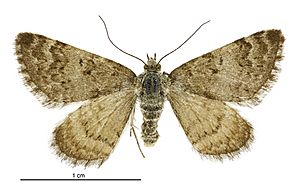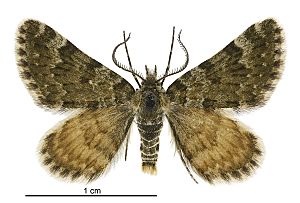Paranotoreas fulva facts for kids
Quick facts for kids Paranotoreas fulva |
|
|---|---|
 |
|
| Female | |
 |
|
| Male | |
| Scientific classification | |
| Genus: |
Paranotoreas
|
| Species: |
fulva
|
| Synonyms | |
|
|
Paranotoreas fulva is a species of moth in the family Geometridae. This species is endemic to New Zealand. It is classified as "At Risk, Relict" by the Department of Conservation.
Contents
Taxonomy
This species was first described and illustrated by George Vernon Hudson in 1905 and was given the name Lythria fulva. Hudson used a specimen collected at about 3500 ft at Wedderburn, Central Otago by J. H. Lewis. Hudson discussed and illustrated this species in his 1928 book The Butterflies and Moths of New Zealand under the name Notoreas fulva. In 1986 Robin C. Craw proposed placing this species within the genus Paranotoreas. The lectotype specimen is held at the Museum of New Zealand Te Papa Tongarewa.
Description
Hudson described the species as follows:
The expansion of the wings is 3⁄4in. The fore wings are dull grey-ish brown, greenish-tinged. There is a wavy darker band near the base ; a broad median band with a strong rounded projection towards the terman above middle ; a dull greenish band on termen preceded by row of pale dots on veins, cilia grey with blackish bars. The hind wings are dull reddish-ochreous. There are three very obscure blackish transverse lines. The cilia are grey, faintly barred with darker.
Distribution
This species is endemic to New Zealand. As well as the type locality, this species has also been found in Alexandra. P. fulva also occurs in the Manorburn Ecological District, as well as at Pisa Flats, Chapman Road Scientific Reserve, Springvale Junction, Moa Creek and other sites in Otago and South Canterbury.
Life cycle and behaviour
This species is a day flying moth. It has been recorded on the wing in March.
Host species and habitat
This species occurs in the salt pans of Otago as well as at tussock grassland areas of montane South Canterbury.
Conservation status
This moth is classified under the New Zealand Threat Classification system as being "At Risk, Relict". This species is under threat as a result of loss of habitat upon which it relies.
Images for kids
 | Chris Smalls |
 | Fred Hampton |
 | Ralph Abernathy |




